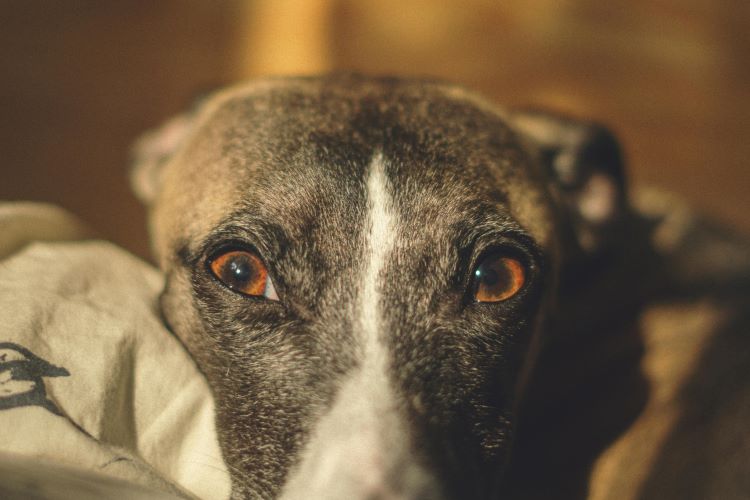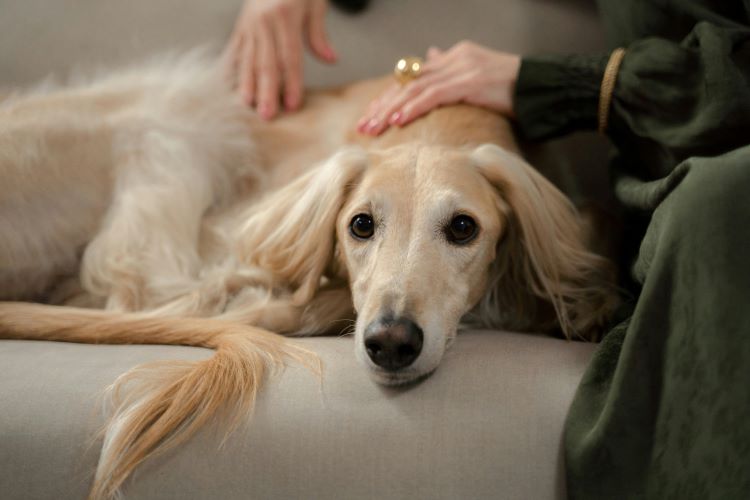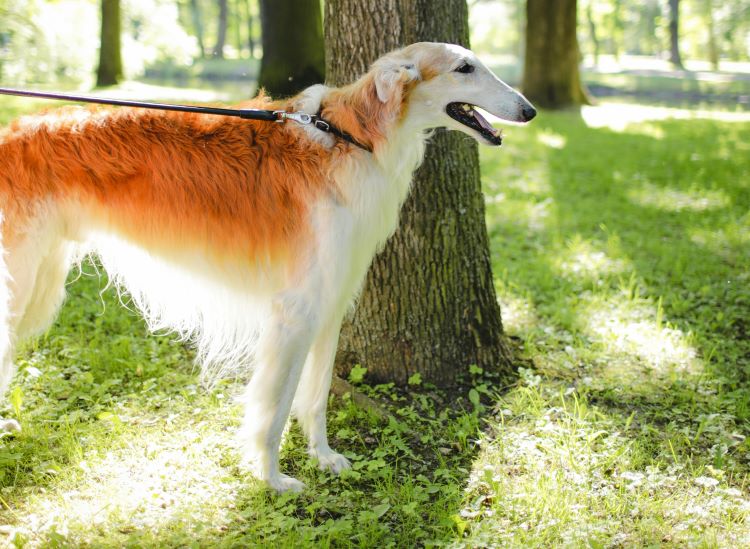Ready to help treat your pet to a healthy life?
What’s a Sighthound? A Look at the Dogs that Rely on Vision
By : Brianna Gunter | Published May 20, 2025

Ever hear of a sighthound? If not, there’s a good chance you’re already familiar with one. That’s because a sighthound is not a dog breed, but a term used for a specific group of hounds that rely on sight and speed when hunting or tracking.
While there are a lot of speedy canines out there, sighthounds — also called “gazehounds” — are unique because other hounds (and other dogs in general) rely more on sense of smell than they do sight. And this isn’t the only thing helping these hunting dogs stand out as a unique group in the pack.
Wondering now if you’ve ever met a sighthound? Let’s take a deeper dive into what characterizes these dogs as well as some popular sighthound breeds.
Common traits of sighthounds
While their reliance on sight is the main factor grouping these breeds together, they have other things in common. Get to know some of these dogs, and you’ll find the following traits are prevalent:
- Long, thin legs with lean muscle
- Slim, aerodynamic bodies
- Thin faces with long snouts
- Large chests that taper sharply upward (this gives them extra breathing capacity)
- Excellent vision, often with a wide field of view
- Calm and gentle temperament, especially indoors
- Extremely fast — some can exceed 40 mph (like the Greyhound)
It’s also important to remember that these are dogs with adept hunting capabilities, even if most modern pups spend their days as family companions. All of their sighthound traits make them better able to spot and chase after fast prey for long periods of time. However, these traits also mean that they can have a strong prey drive, even when they are calm and gentle most of the time. Proper introductions between sighthounds and other pets (and children) is crucial for establishing safe relationships, as is ensuring these dogs get sufficient daily exercise and mental stimulation.
History
Sighthounds are thought to come from early domesticated dogs, being selectively bred by humans to hone their hunting skills. But like most kinds of dogs, the exact origins of sighthounds is unclear, relying mostly on anecdotal accounts. However, some sighthound breeds are known to be among the oldest dog breeds in the world. The group as a whole is believed to date back at least 2,000 years as per historical accounts, though certain sighthounds may go back 5,000 years or more.

8 popular sighthound breeds
There are nearly 30 sighthound breeds currently recognized between the American Kennel Club (AKC), Canadian Kennel Club (CKC), and The Kennel Club from the UK. However, these organizations will generally group these dogs together with scenthounds into one big “hound group” during competitions.
There are also various sighthound crossbreeds, plus a number of dogs sometimes recognized as sighthounds by both formal and informal dog groups even though they may not be hunting breeds and also may not rely solely on sight and speed. For example, the Ibizan Hound shares many of the same characteristics as sighthounds and is often called one, but it uses scent as well as sight and speed to track prey.
So, to avoid complicating things, we’re just going to focus today on breeds that are recognized by the world’s leading kennel clubs as sighthounds. Here are eight sighthound breeds worth knowing:
1. Greyhound
The Greyhound is arguably the most well-known sighthound in the world thanks to their status as the fastest dog breed. These sleek, muscular pups have a history as racing dogs, which involves them running around a track chasing a visual target. Though despite their athleticism, Greyhounds are also known for their love of lounging around the home as lower-energy pets. Hey, they’re sprinters, not endurance runners.
2. Whippet
The Whippet is believed to be a close relative of the Greyhound and looks so similar that the two breeds are often mistaken for one another. But pay close attention and you’ll spot some key differences. For example, Whippets are smaller than their Greyhound counterparts and, while they can run quite fast, do not reach as high speeds. Even so, the Whippet is said to be the second-fastest dog in the world, so they’re still pretty impressive runners.
3. Irish Wolfhound
If you’ve ever seen an Irish Wolfhound in person, you’d remember. This is one of the world’s tallest dog breeds, towering above their humans when standing on their haunches. But don’t be intimidated by their size — Irish Wolfhounds tend to be gentle giants, being patient with children and most people. Still, they are a big commitment that require more care than the average dog.
4. Scottish Deerhound
As its name suggests, the Scottish Deerhound gained fame being used to hunt deer in Scotland, though they have proven skilled as hunting dogs for other types of game as well. Modern Scottish Deerhounds are more commonly found as companion animals, beloved for their trainability and dependable loyalty.
5. Afghan Hound
Originating in Afghanistan, the Afghan Hound or simply, “Afghan,” is an ancient breed perhaps best known for its long, silky coat and curved tail that gives it an elegant appearance. Let’s be honest — these dogs are downright gorgeous. But while it’s easy to see that their faces have the long, slim shape found in other sighthounds, all that beautiful hair can make it tough to see that trademark sighthound build!
6. Saluki
The Saluki is often cited as not just the oldest sighthound, but the oldest dog breed in the world because it looks so much like dogs found on pottery and wall art dating back to 6,000 BC or earlier. It’s unclear if the Saluki actually holds this title, but what is known is that these dogs are lovely creatures who are also called “Persian Greyhounds” due to their similar stature and appearance to Greyhounds, albeit with longer, silkier coats.
7. Sloughi
The Sloughi (sloo-ey) is also called the Arabian Greyhound, and it doesn’t take long to see why. Hailing from Northern Africa, these sleek canines look like shorter, slightly thicker Greyhounds, and they’re renowned for their running capabilities. Unlike the Greyhound though, the Sloughi actually excels at endurance running and was bred to pursue prey over long distances.
8. Borzoi
Also known as the Russian Wolfhound or “Russian Hunting Sighthound” for those not into brevity, the Borzoi was, surprise surprise, used for hunting wolves. But modern dog owners know this pup is so much more than its origins hunting for the Russian aristocracy — these graceful dogs are gentle and sensitive, typically getting along well with people and other pets.

Sighthound health risks
Sighthounds have some pretty unique physical and biological traits, likely due to their early ancestors being bred specifically for hunting by speed and sight. Lab studies have helped establish typical ranges for things like blood work and biochemistry in these dogs — some of these traits are common across all sighthound breeds, while others might be specific to just one or two.
Overall, health conditions sighthounds are at risk for vary by breed and lifestyle. When bred responsibly, sighthounds (and hounds in general) are considered to be healthy dogs. That said, some more commonly-found conditions in these pups include:
- Joint dysplasia
- Ear infections
- Eye conditions (like glaucoma and cataracts)
- Skin irritation
- Canine bloat
Protect your dog’s health, regardless of breed
Whether you’ve got your own sighthound in the family or a different type of dog breed entirely, it’s important to prioritize their health. You can do this by feeding your pet a healthy diet, bringing them out for daily exercises, not skipping veterinary checkups, and keeping up with routine care like vaccinations and monthly parasite control.
However, even with the best precautions, it’s impossible to ensure no accidents or surprise illnesses will ever happen to your dog. Fortunately, pet insurance can help keep dogs of all breeds protected, whether they’re a sighthound or another type of special canine.
Enjoy learning about cool types of dogs? Check out this list of doodle dogs and what makes them unique.
